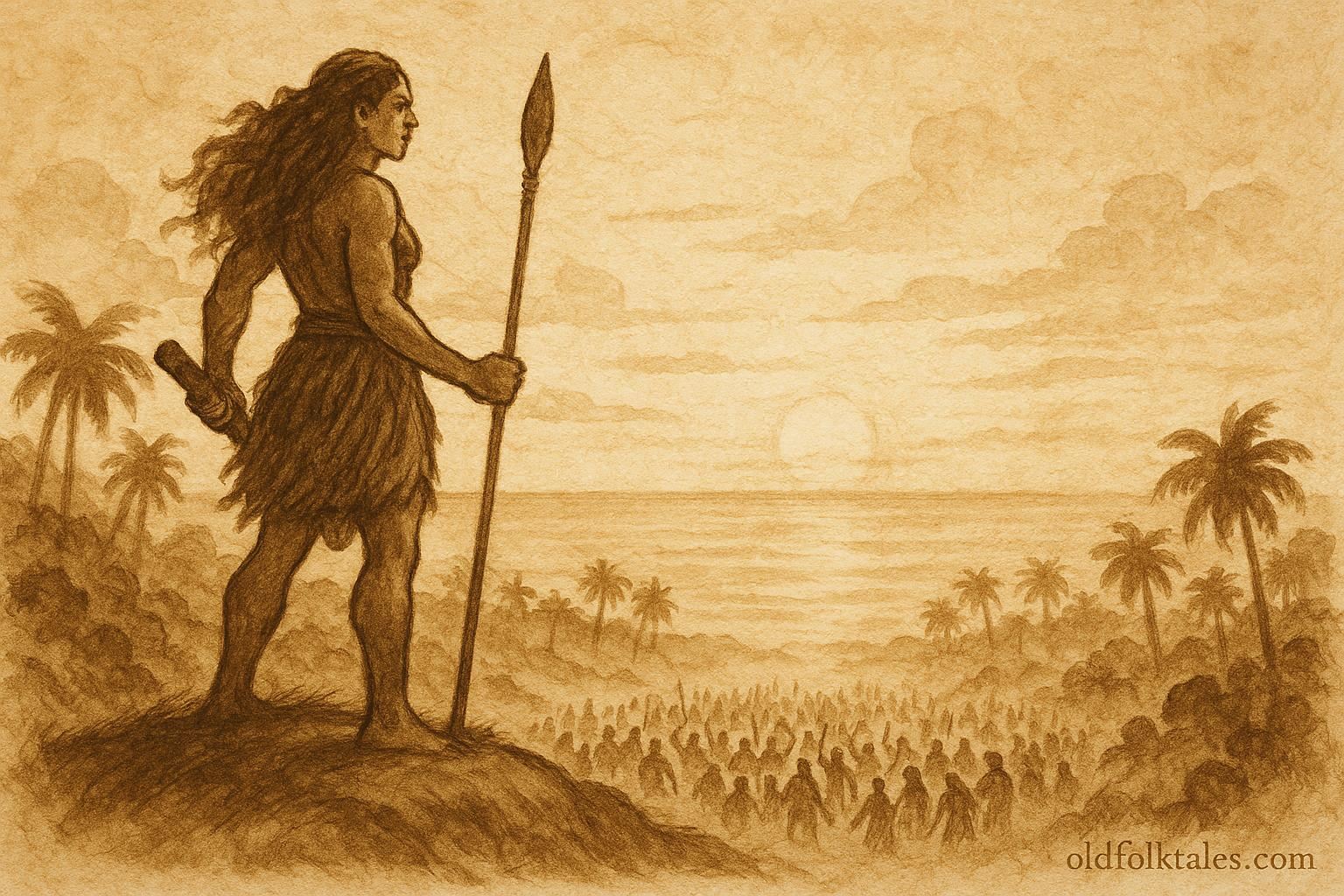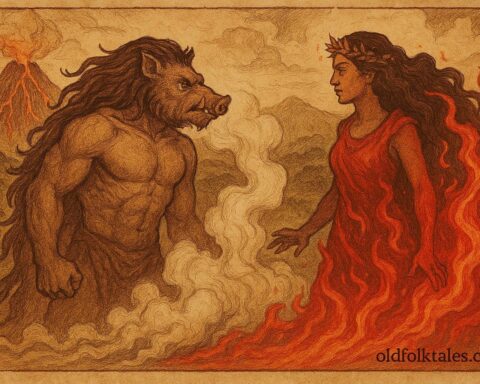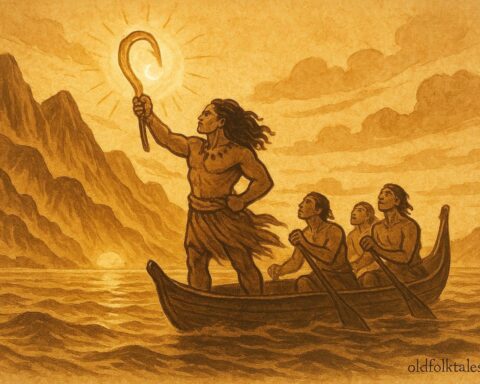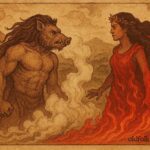Long ago, in the time when the gods walked among mortals and the sea carried the voices of spirits, the islands of Samoa were divided by endless warfare. Chiefs battled for power, villages burned, and blood stained the sands where once there had been peace. The cries of the wounded and the clash of spears echoed across the valleys, rising up toward the heavens.
Beneath this troubled world, deep in the Pulotu, the underworld realm ruled by spirits, a divine being watched in silence. Her name was Nafanua, daughter of Saveasi‘uleo, the mighty god of war and the ruler of Pulotu. Though her father commanded the forces of battle and death, Nafanua’s heart held both the fire of the warrior and the gentleness of mercy.
Sail through the legends of brave navigators, ocean spirits, and island gods
From her earliest days, Nafanua was unlike others in the underworld. She trained among the guardians of Pulotu, mastering the art of war, yet she often sat beside the spirit rivers, listening to the soft flow of water over stones. She knew that even in the realm of the dead, peace had its place. Her father, Saveasi‘uleo, watched her grow in strength and wisdom, and one day said,
“Daughter, the world above is torn by hatred. The people of Samoa destroy what the gods have given. It is time for you to rise and restore balance.”
Hearing these words, Nafanua felt her spirit blaze with purpose. She took up her sacred weapons, a club, a spear, and the va‘a o le toa, the canoe of warriors, and prepared to ascend to the mortal world. As she emerged from the shadowed depths of Pulotu, the winds stirred and the ocean glimmered. Fishermen who saw her rise from the sea spoke of a figure radiant as dawn, armored in leaves and glistening with seawater, her eyes bright with the light of the gods.
When Nafanua reached the islands, she found a land fractured by war. Chiefs waged endless battles to claim power. Among the fiercest of them was the chief Lilomaiava, whose ambition threatened to enslave neighboring tribes. Villages feared his armies, and peace seemed lost forever.
Nafanua walked into this chaos not as a destroyer, but as a restorer. She gathered those who still longed for justice, the outcasts, the weary, and the oppressed, and forged them into her warriors. Under her command, they fought not for conquest but for freedom. Her battle cries rang across the plains, fierce yet filled with righteousness. Wherever her forces marched, the tide of war began to turn.
Stories say that in battle, Nafanua’s power was unstoppable. Her movements were like the rhythm of the ocean, swift, fluid, and unyielding. She fought with divine grace, her club flashing like lightning, her voice echoing like thunder. Yet she did not kill needlessly. When enemies surrendered, she spared their lives, commanding them instead to lay down their weapons and join in the rebuilding of their land.
Word of her victories spread quickly. The tribes who once lived in fear began to unite under her banner. Even her enemies, awed by her courage and fairness, bent their knees in respect. One by one, the warring chiefs sent emissaries to her camp, pledging loyalty to her vision of peace. Nafanua did not boast of her power or claim dominion for herself. She said only:
“Let Samoa belong not to one chief, but to all its children. Let strength serve justice, and justice serve peace.”
In time, Nafanua’s wisdom restored balance to the islands. She divided power among the tribes so that no single chief would rule over all. The people, grateful for her leadership, crowned her the Goddess of War and Peace. Under her guidance, Samoa flourished again. The fires of destruction faded, and the villages were rebuilt with song and celebration.
But Nafanua, though beloved, did not stay forever among mortals. When her work was done, she returned to Pulotu. Before she departed, she stood upon a high mountain, looking over the peaceful islands bathed in golden light. The waves below whispered against the reefs, and she spoke softly to the wind:
“Remember me not for my battles, but for the peace that followed them. True victory is not in conquest, but in mercy.”
With that, she vanished into the horizon, carried back to the underworld by the sea’s embrace. Yet her spirit remained, in the calm after storms, in the courage of leaders who rule with fairness, and in the hearts of Samoan women who draw strength from her example.
To this day, the people of Samoa honor Nafanua as both warrior and peacemaker, protector and guide. Her image adorns sacred places, her name is invoked in times of conflict, and her story is told to remind the living that even in the heart of war, compassion can wield the mightiest power.
Discover the adventures of Māui, Pele, and Tangaloa in the timeless Polynesian oral tradition
Moral Lesson
The story of Nafanua teaches that true strength is not measured by destruction, but by the power to bring peace. Leadership rooted in mercy can heal what violence divides. Through wisdom, justice, and compassion, harmony can rise even from the ashes of conflict.
Knowledge Check
1. Who is Nafanua in Samoan mythology?
Nafanua is the daughter of the war god Saveasi‘uleo and the goddess of both war and peace in Samoan mythology.
2. Why did Nafanua rise from the underworld?
She ascended to the mortal world to unite warring tribes and restore harmony to Samoa.
3. What weapons did Nafanua carry?
She carried a sacred club, a spear, and the canoe of warriors known as the va‘a o le toa.
4. How did Nafanua show mercy during war?
She spared enemies who surrendered and invited them to help rebuild the land instead of destroying them.
5. What leadership lesson does Nafanua’s story teach?
That true leadership combines courage with compassion, using power to heal rather than dominate.
6. Why is Nafanua remembered as a symbol of balance?
Because she embodied both the fierce strength of war and the gentle wisdom of peace, ensuring harmony after conflict.
Source: Adapted from Samoan Mythology: Legends and Traditions of the Samoans by Augustin Krämer (1902, translated 1994).
Cultural Origin: Samoa (Polynesia).












